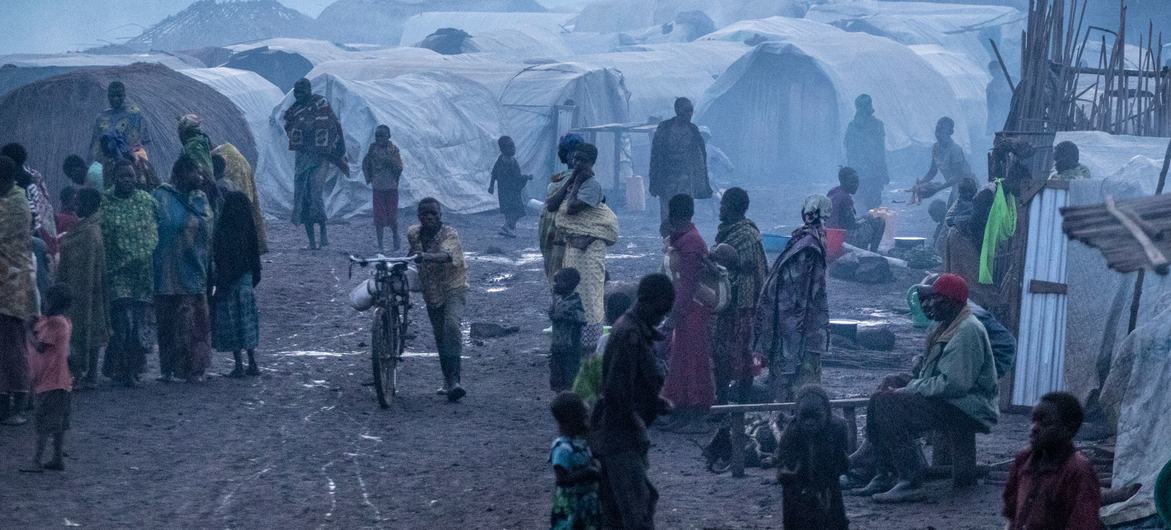[ad_1]
“The Democratic Republic of Congo (DRC) has the most important inhabitants of internally displaced individuals on the African continent: 5.9 million individuals, together with 700,000 newly displaced individuals this 12 months. The DRC can also be internet hosting over 500,000 refugees and asylum-seekers (primarily from Burundi, the Central African Republic, and South Sudan).
The components driving inside displacement are sometimes complicated and interconnected, from conflicts, local weather associated shocks, disasters, to rising charges of violent crime.
Within the DRC, the protracted conflicts within the Jap Provinces of Ituri, North Kivu and South Kivu, in addition to renewed tensions within the central southern areas of Kasai and Tanganyika, have been the important thing supply of displacement within the nation, forcing thousands and thousands of individuals to depart their houses, usually on a number of completely different events.
Because the inter-communal conflicts within the Jap Provinces roll into their second decade, and tensions and violence over the usage of land and exploitation of pure assets proceed, together with by way of the various armed teams lively in these areas, extra displaced households are compelled to rely on humanitarian help in an effort to survive.

© UNICEF/Roger LeMoyne
Internally displaced individuals (IDPs) at Loda IDP camp in Fataki, Ituri Province, Democratic Republic of the Congo.
Untying the ‘Gordian knots’
As we all know, humanitarian help – though essential to alleviate struggling within the brief time period – is just not sufficient to unravel the deep-rooted, structural challenges driving inside displacement.
The necessity to discover sturdy and long-lasting options to the problem of inside displacement within the DRC couldn’t be extra pressing.
Discovering coherence and redressing the steadiness between humanitarian, peacebuilding and growth motion is essential, and is the primary of many steps needed to construct longer lasting options to inside displacement and meet the wants of the thousands and thousands of individuals stranded in IDP websites.
Over the previous few years, we – the UN nation staff within the DRC in addition to the Humanitarian Nation staff – have been working intently with the Authorities of the DRC and provincial authorities, together with different growth, humanitarian, and peacebuilding companions, to implement the humanitarian-development-peace nexus.
By working in coordination with nationwide and worldwide companions, this nexus-based technique strikes away from the undertaking centric strategy to sort out the important thing structural causes of inside displacement – what I’ve come to confer with because the ‘Gordian knots.’
Constructing on my current expertise in Haiti because the Resident and Humanitarian Coordinator and Deputy Particular Consultant of the Secretary-Basic, I’ve additionally come to acknowledge the significance of working with nationwide authorities to scale up and implement current public insurance policies so as enhance the nation’s growth trajectory.

©FAO/Frank Ribas
Girls and youngsters displaced by violence working of their vegetable backyard in Kalemie, Tanganyika the place FAO supplies seeds and instruments in order that displaced households and the native inhabitants can develop greens.
Planting the seeds of growth
On the middle of this strategy is the popularity that after 20 years of reliance on the humanitarian neighborhood and the presence of UN’s peacekeeping forces (MONUSCO), which play a necessary position in defending civilians, we have to open up extra space to growth actors within the DRC – and work in a extra balanced strategy to tackle each the signs and drivers of displacement.
Even in the course of the present interval of disaster and escalating violence, I’ve come to see simply how essential it’s to plant the seeds of growth and tackle the underlying vulnerabilities which have uprooted so many households throughout the nation within the first place.
Throughout a number of visits to Tanganyika province, which has excessive ranges of IDPs, I used to be struck by simply what number of various factors – each the signs and drivers of displacement – are at play, together with excessive ranges of meals insecurity, the problem to entry companies, competitors over the area’s wealth of pure assets, and escalating violence in opposition to civilians. ]
I spoke with many IDPs throughout these visits to Tanganyika province, every of them sharing their very own story of displacement and explaining the robust situations they at the moment reside below. Listed below are a number of the issues they advised me.
‘The factor we wish most on this planet is to return residence, to domesticate our land, however the safety situations usually are not there but – and so we’ve to proceed to reside in these troublesome situations.’
‘We would like peace to return as a result of solely lasting peace can permit us to return to our villages.’
Discovering an enduring answer to compelled displacement on this a part of the nation clearly requires the involvement of many various actors – peacebuilders, humanitarians, growth companions and native authorities – all working collectively in the direction of one widespread sport plan and collective outcomes.
Growth can have an essential multiplier impact, serving to to strengthen native actors and techniques, enhance native financial growth and assist a return of State authority.
Working with native organizations, together with NGOs and civil society organizations is vital. We should proceed to stroll the speak on localization
In japanese DRC, a area which has over relied on humanitarian actors for the supply of social companies and public infrastructure previously, empowering native state actors is a key step to constructing extra sustainable options to displacement, and one which we on the UN nation staff will proceed to prioritize within the years forward.

© UNOCHA
Throughout a go to to Tanganyika in March 2022, the Resident and Humanitarian Coordinator meets colleagues from FAO and WFP who’re offering assist to internally displaced individuals dwelling within the website.
A hopeful highway forward
The UN Secretary-Basic’s Motion Agenda on Inside Displacement, marks an essential step on this route.
Constructing on the suggestions from the Excessive-Stage Panel on Inside Displacement on the finish of 2019, the Motion Agenda units out a sequence of commitments for the UN system to step up its engagement and construct longer lasting options to inside displacement, by putting prevention, safety and native partnerships on the centre.
The challenges forward for the DRC are important, however I’m hopeful that the brand new Motion Agenda, alongside the nexus-based strategy, will be sure that displaced communities are additional protected, native authorities strengthened, and growth actors delivered to scale”.
[ad_2]
Source_link


